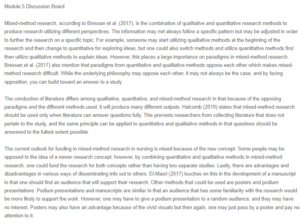Peer Response – Importance of Paradigms in Mixed-Method Research
Do you need an unpublished edition of “Peer Response – Importance of Paradigms in Mixed Method Research” Get in touch with us.
Hello Steph,
Thank you for sharing your post. You have presented a good understanding of mixed methods research and why paradigms matter in mixed methods research. As you have noted, MMR is becoming acceptable in healthcare research due to the quality of evidence by leveraging the combined strengths of qualitative and quantitative research techniques to tackle complex research problems. Let me add on the paradigms and how they resolve the design conflict in MM research. Arguably, combining qualitative and quantitative methods brings together presumably irreconcilable and irreconcilable worldviews (McChesney & Aldridge, 2019). Mixed methods apply various research paradigms that are either strictly applicable only to qualitative or quantitative methods. A mixed-method study paradigm is simply the philosophical assumptions and worldviews underpinning the researcher’s approach to understanding the research problem.
The four major paradigms are postpositivism, constructivism, transformative, and pragmatism. From your discussion, you have noted that paradigms MM research outline the purpose of the study, which is to provide a clear understanding of the purpose and provide validity. This means that the paradigms influence how the research data is collected, analyzed, and interpreted (Ghiara, 2020). Therefore, paradigms determine how the researcher designs their study. MM research designs include embedded explanatory, exploratory, and convergent parallel designs. The MM research designs use the concept of paradigms as a framework for enabling the researchers to reflect on their assumptions about reality, methodology, and epistemology (Ghiara, 2020). In this case, the research designs present different ways of combining the two incompatible research methods and resolving the methodological conflict that arises from using mixed methods research. Therefore, as a researcher in healthcare and nursing, it is important to be aware of the various MMR designs and paradigms to conduct rigorous research that can effectively explore and answer a research problem.
References
Ghiara, V. (2020). Disambiguating the Role of Paradigms in Mixed Methods Research. Journal of Mixed Methods Research, 14(1), 11–25. https://doi.org/10.1177/1558689818819928/ASSET/IMAGES/LARGE/10.1177_1558689818819928-FIG1.JPEG
McChesney, K., & Aldridge, J. (2019). Weaving an interpretivist stance throughout mixed methods research. International Journal of Research and Method in Education, 42(3). https://doi.org/10.1080/1743727X.2019.1590811
ORDER A PLAGIARISM-FREE PAPER HERE
We’ll write everything from scratch
Question

Peer Response – Importance of Paradigms in Mixed-Method Research
REPLY TO MILLIE DISCUSSION POST
Module 5 Discussion Board
Mixed-method research, according to Bressan et al. (2017), is the combination of qualitative and quantitative research methods to produce research utilizing different perspectives. The information may not always follow a specific pattern but may be adjusted in order to further the research on a specific topic. For example, someone may start utilizing qualitative methods at the beginning of the research and then change to quantitative for exploring ideas, but one could also switch methods and utilize quantitative methods first then utilize qualitative methods to explain ideas. However, this places a large importance on paradigms in mixed-method research. Bressan et al. (2017) also mention that paradigms from quantitative and qualitative methods oppose each other which makes mixed-method research difficult. While the underlying philosophy may oppose each other, it may not always be the case, and by facing opposition, you can build toward an answer to a study.
The conduction of literature differs among qualitative, quantitative, and mixed-method research in that because of the opposing paradigms and the different methods used, it will produce many different outputs. Halcomb (2019) states that mixed-method research should be used only when literature can answer questions fully. This prevents researchers from collecting literature that does not pertain to the study, and the same principle can be applied to quantitative and qualitative methods in that questions should be answered to the fullest extent possible.
The current outlook for funding in mixed-method research in nursing is mixed because of the new concept. Some people may be opposed to the idea of a newer research concept, however, by combining quantitative and qualitative methods in mixed-method research, one could fund the research for both concepts rather than having two separate studies. Lastly, there are advantages and disadvantages in various ways of disseminating info out to others. El-Masri (2017) touches on this in the development of a manuscript in that one should find an audience that will support their research. Other methods that could be used are posters and podium presentations. Podium presentations and manuscripts are similar in that an audience that has some familiarity with the research would be more likely to support the work. However, one may have to give a podium presentation to a random audience, and they may have no interest. Posters may also have an advantage because of the vivid visuals but then again, one may just pass by a poster and pay no attention to it.
References
Bressan, V., Bagnasco, A., Aleo, G., Timmins, F., Barisone, M., Bianchi, M., Pellegrini, R., & Sasso, L. (2017). Mixed-methods research in nursing – a critical review. Journal of Clinical Nursing, 26(19–20), 2878. https://doi-org.ezproxy.una.edu/10.1111/jocn.13631Links to an external site.
El-Masri, M. M. (2017). Preparing a publishable research manuscript: Practical guidelines. Canadian Nurse, 113(6), 20–23.
Halcomb, E. J. (2019). Mixed methods research: The issues beyond combining methods. Journal of Advanced Nursing, 75(3), 499. https://doi-org.ezproxy.una.edu/10.1111/jan.13877Links to an external site.


